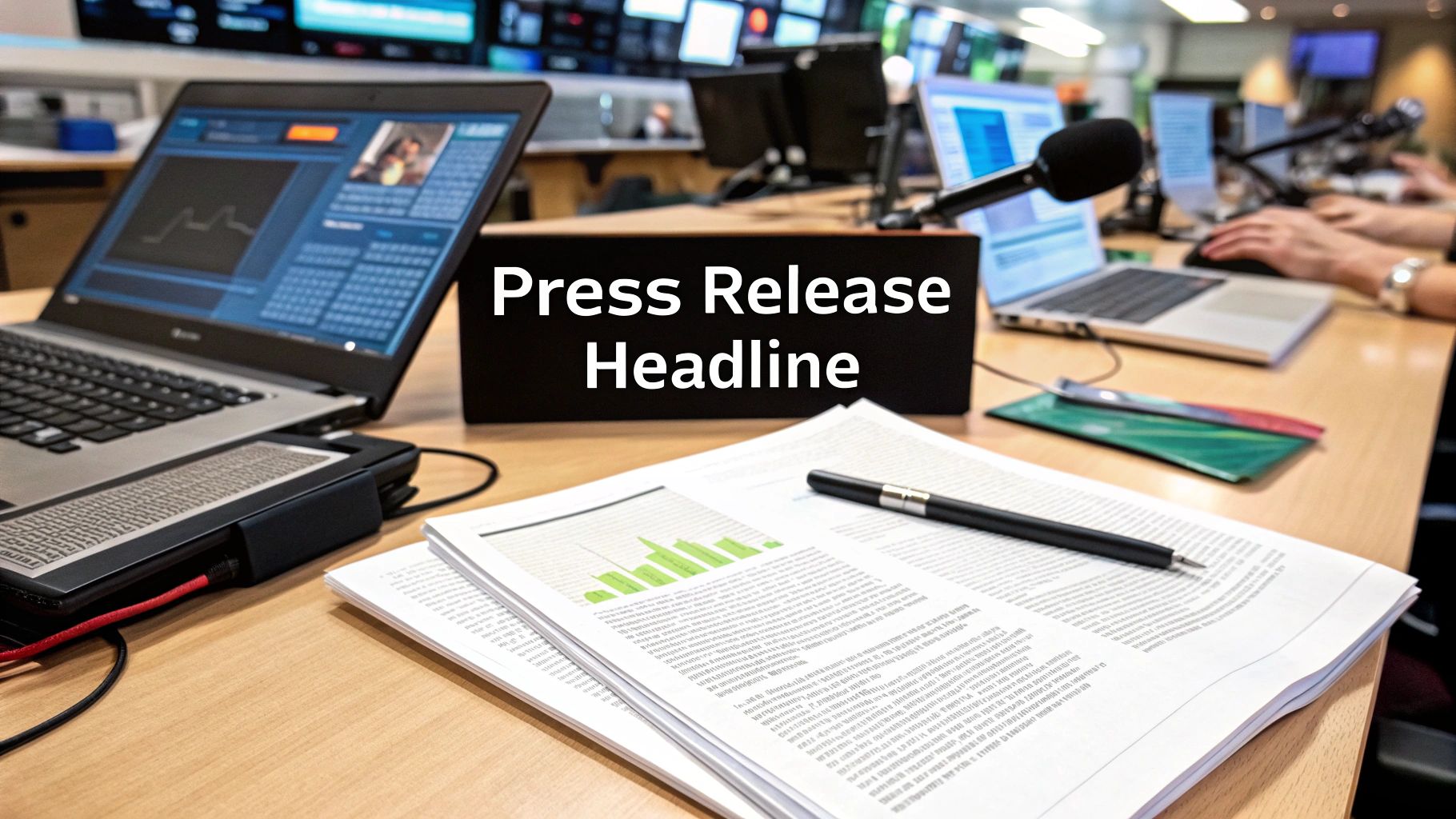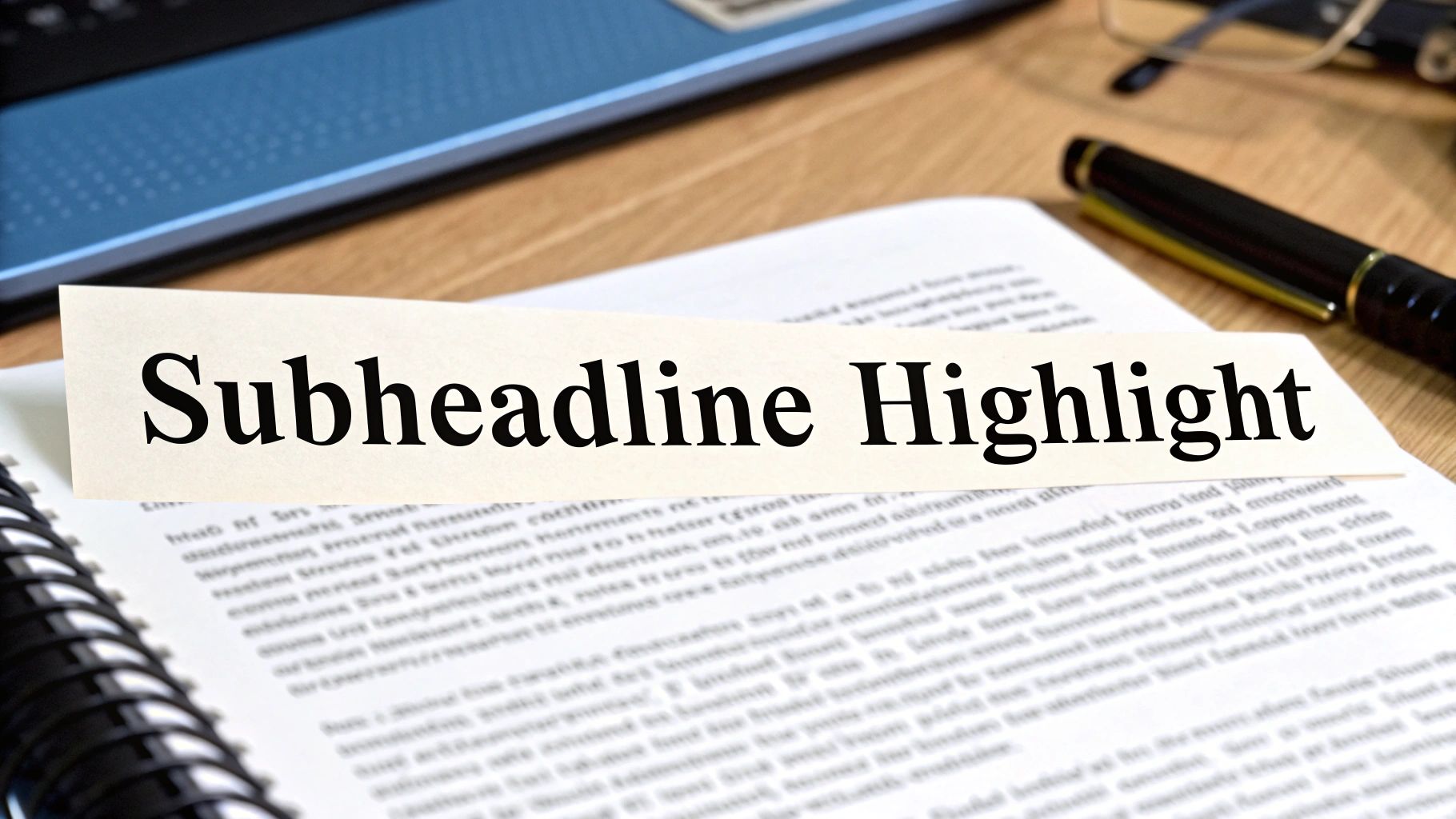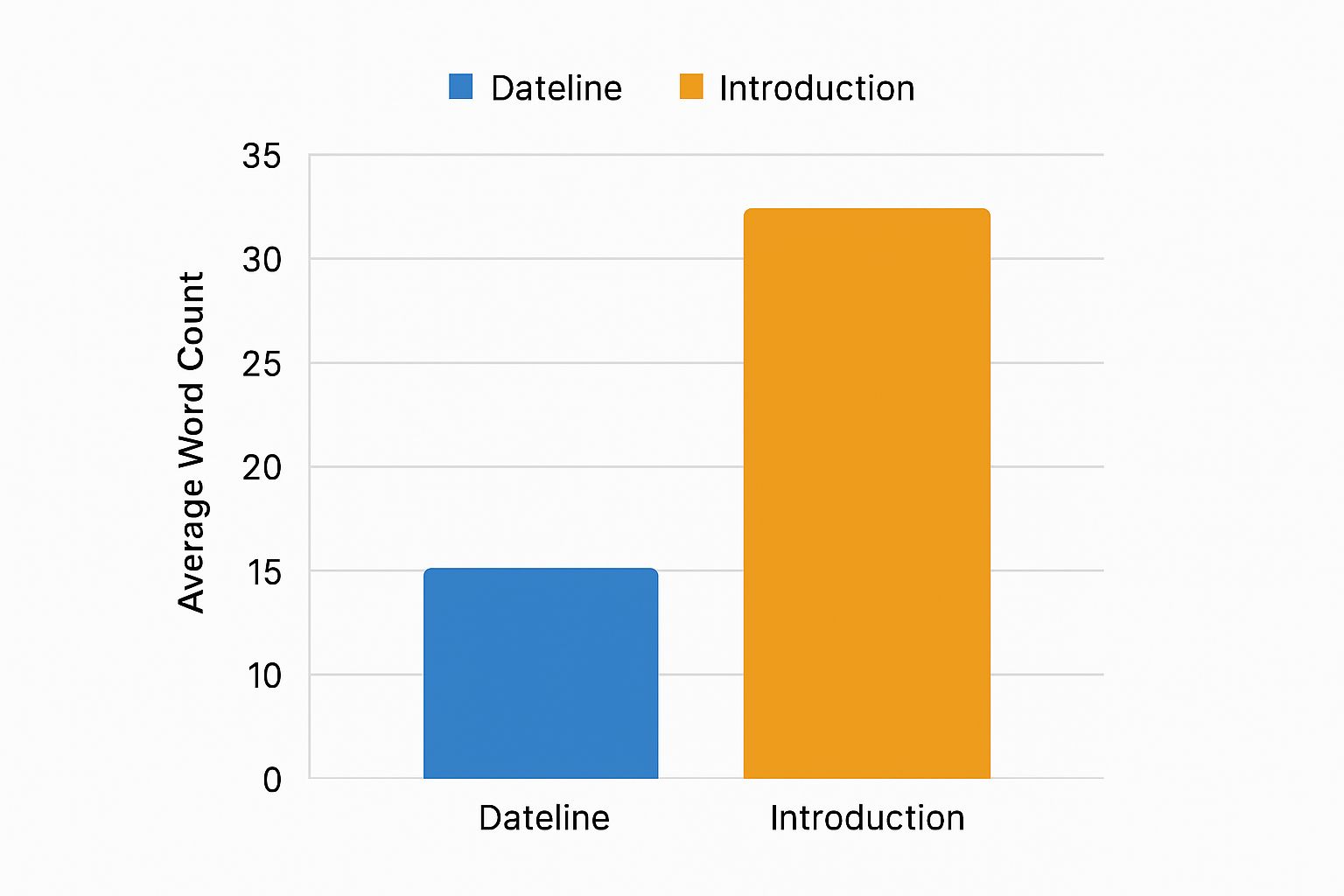
Press Release Format: Guide to Crafting Effective Releases
The Anatomy of High-Impact Press Release Formats

Let's explore the elements of a truly effective press release in the UK. Crafting a well-structured press release is essential for capturing the attention of journalists, who are constantly bombarded with information. It's not simply about adhering to a template; it's about understanding how journalists operate and tailoring your approach accordingly. This involves presenting your information strategically, respecting their time, and aligning with UK media expectations.
Understanding The Standard Press Release Format
The standard press release format serves a crucial purpose: it offers a familiar and effective way for journalists to swiftly evaluate the newsworthiness of your story. Think of it as a storefront window – your most captivating offerings should be displayed prominently. This structured approach showcases professionalism and ensures your information is easily accessible. For example, a compelling headline and a concise opening paragraph are vital for grabbing attention.
Key Components and Their Importance
The core components of a press release work in harmony to tell a compelling story. The headline serves as the initial hook, drawing readers in, while the dateline provides crucial context. The lead paragraph then expands on the headline, offering a succinct summary of the key news. The body delves deeper, providing supporting details and insightful quotes. Finally, the boilerplate gives background information about your organization, and the contact information allows journalists to easily follow up.
Formatting For Clarity and Impact
The format of your press release is just as important as the content itself. Short paragraphs, bullet points, and clear headings make it easy to scan. This is particularly crucial in today's fast-paced media landscape, where journalists often read on the go. Consider incorporating multimedia, such as images or videos, to further engage your audience and enhance shareability. Understanding the broader context of information dissemination in the UK is also valuable. Discover more insights about UK data here. This research can help you strategically craft and distribute your press releases.
Tailoring Your Format to The UK Media Landscape
While the fundamental press release format is universal, subtle adjustments can significantly improve its reception in the UK. Using UK-specific terminology and referencing relevant local events demonstrates your understanding of the market. Adhering to UK media style guides signals professionalism and boosts your credibility. This includes using correct spellings (e.g., "organisation" not "organization") and following preferred date and time formats. By catering to the specific needs and expectations of UK journalists, you greatly improve your chances of securing valuable media coverage.
Crafting Headlines That Journalists Can't Ignore

The headline of your press release is its most vital element. It's the first impression, and often the only impression, you'll make on a journalist. A weak headline almost guarantees your press release will be ignored. This section explores how to craft headlines that capture attention and inspire journalists to read your story.
Understanding the Psychology of a Great Headline
A truly great headline speaks to our natural curiosity. It suggests something valuable, a story waiting to be discovered. Think about it: "New Fintech App Simplifies UK Savings" resonates more deeply than "Company Launches New App." Focus on the benefit, the impact of your news, not just the announcement itself. A compelling headline draws readers in. For further guidance on crafting compelling headlines, check out this resource on how to write good headlines.
Keyword Placement and Character Count for Headlines
Your headline needs to work for both search engines and people. Smartly positioning relevant keywords, such as "press release format," early in the headline boosts visibility. But resist the urge to overstuff your headline with keywords! Maintain a natural, readable flow. Keep in mind character count, too. Aim for under 70 characters to ensure your headline displays correctly on all platforms, particularly mobile devices and social media.
Balancing Creativity with Clarity in Your Headlines
While a touch of creativity helps your headline stand out, clarity is paramount. Avoid jargon, complex language, and misleading clickbait. Your goal is to communicate your core message clearly and concisely, allowing journalists to quickly grasp the essence of your story. For instance, instead of "Disruptive AI Algorithm Changes the Market," consider "New AI Algorithm Predicts Market Trends with 90% Accuracy." The second headline offers concrete value and generates immediate interest.
Let’s pause here to examine the effectiveness of different headline styles:
To illustrate this point, let’s look at a table summarizing different headline approaches:
Headline Effectiveness Comparison
This table compares different headline styles and their effectiveness in press releases.
| Headline Style | Example | Strengths | Weaknesses | Best Used For |
|---|---|---|---|---|
| Direct | New Software Released | Clear, concise | Can be boring | Straightforward announcements |
| Benefit-driven | New Software Automates Tax Returns, Saving Hundreds of Hours | Highlights value | Can be lengthy | Product launches, feature updates |
| Intriguing | Is This the End of Manual Tax Returns? | Generates curiosity | Can be vague | Thought leadership, controversial topics |
| News-driven | Manchester Charity Raises Record Funds for Homeless | Strong impact | Requires significant news | Major announcements, milestones |
By considering these different styles, you can tailor your headlines to best suit your news and target audience. Remember, a strong headline significantly increases your chances of media pickup.
From Ignored to Featured: Real-World Examples
Here are a few before-and-after examples to illustrate the power of a well-crafted headline:
-
Before: Company Launches New Software
-
After: New Software Automates Tax Returns for UK Businesses, Saving Hundreds of Hours
-
Before: Local Charity Holds Fundraising Event
-
After: Local Charity Raises £10,000 for Homeless Shelter in Manchester
The improved headlines showcase the real-world impact and relevance of the news, making them far more attractive to journalists. They emphasize concrete benefits and add a local angle for increased engagement. This approach ensures your press release gets noticed and boosts your chances of securing valuable media coverage.
Essential Press Release Components That Drive Results

A well-structured press release is more than just information. It’s a powerful narrative, carefully crafted to inform and persuade. Each component plays a vital role in captivating journalists and ensuring your message resonates. Let's explore the key elements that make a press release truly stand out.
The Foundation: Dateline and Release Instructions
The dateline immediately sets the scene, providing crucial context. It states the city and date, like "LONDON, UK – 27 October 2024". Release instructions, such as "For Immediate Release", follow, signaling the news’s timeliness. This clear framework ensures journalists know when and where the story originates.
Crafting Compelling Quotes and Boilerplates
Direct quotes add a human element and build credibility. Go beyond the generic. Instead, offer unique perspectives. A CEO quote, for example, could explain the news's impact on the industry. The boilerplate, a brief company overview, provides essential background for unfamiliar journalists, summarizing your mission and market position.
Formatting for Readability and Engagement
Compelling content needs clear formatting. Journalists value readability. Use short paragraphs, bullet points, and headings for scannable content. Multimedia, like images or videos, boost engagement and shareability across platforms, ensuring key messages are easily absorbed.
Contact Information: The Gateway to Further Engagement
Accessible contact information is crucial. Journalists need to easily follow up. Provide a designated contact's name, email, and phone number. Encourage interaction by mentioning your availability. A simple "For further information or interview requests, please contact us" can significantly increase media engagement.
Modern Press Release Requirements: Multimedia, Links, and Accessibility
Press releases need to embrace online platforms. High-quality images, videos, and infographics enhance engagement. Use descriptive anchor text for links. Prioritize accessibility with alt text for images, broadening your reach and promoting inclusivity. This demonstrates a modern media understanding. Statistical data from the UK's media regulator, Ofcom, provides further insights into media consumption patterns.
The following data chart visualizes optimal word counts for press release components:
Press Release Component Word Count
| Component | Word Count |
|---|---|
| Headline | 10-15 |
| Lead Paragraph | 25-30 |
| Body Paragraphs | 200-250 |
| Quote | 40-60 |
| Boilerplate | 50-75 |
This chart emphasizes conciseness, especially in the headline and lead, where capturing attention is paramount. Body paragraphs allow for detail, while the quote and boilerplate provide concise context.
To help you craft a winning press release, here is a handy checklist:
Press Release Component Checklist
| Component | Purpose | Formatting Guidelines | Word Count | Must-Include Elements |
|---|---|---|---|---|
| Headline | Grab attention, summarize the news | Bold, Title Case, Concise | 10-15 words | Keywords, Main Topic |
| Dateline | Provide context of location and time | City, State, Date | City, Date | |
| Release Instructions | Indicate release timing | "For Immediate Release" or specific embargo date | Clear instruction | |
| Lead Paragraph | Expand on the headline, provide key details | 25-30 words | Who, What, Where, When, Why | |
| Body Paragraphs | Provide supporting information and details | Short paragraphs, bullet points | 200-250 words | Supporting facts, quotes, data |
| Quote | Add credibility and human perspective | 40-60 words | Relevant, insightful quote from a key figure | |
| Boilerplate | Briefly describe the organization | 50-75 words | Company mission, background information | |
| Contact Information | Facilitate media follow-up | Name, Title, Email, Phone Number | Accurate contact details | |
| Multimedia | Enhance engagement and shareability | High-resolution images, videos, infographics | Captions, alt text | |
| Links | Direct readers to relevant resources | Descriptive anchor text | Accurate and relevant links |
This checklist helps ensure your press release contains all the essential components, formatted effectively for maximum impact. Remember, a well-crafted press release is an investment in your brand's visibility and success.
Industry-Specific Press Release Format Adaptations

The core structure of a press release remains constant, yet its application across different industries demands careful thought. Much like a tailored suit, a press release crafted with its specific industry in mind will resonate more powerfully with the intended audience. This involves understanding the subtle differences between sectors and adjusting your communication accordingly. Let's explore how this works across various sectors in the UK.
Finance: Clarity and Compliance
In the financial world, accuracy and adherence to regulations are essential. Press releases must be precise, leaving no room for misinterpretation or exaggerated claims. This requires using clear, factual language and concentrating on concrete data. Furthermore, releases often must comply with specific regulations, such as those established by the Financial Conduct Authority (FCA). For guidance on content, exploring sample release notes can be invaluable. This precision fosters trust and credibility, vital components in this sector.
Technology: Balancing Innovation and Accessibility
The technology industry thrives on innovation, and press releases should mirror this energy. While technical terms might be unavoidable, it's crucial to balance them with clear explanations for a wider audience. Focus on the practical uses of new technologies and how they benefit users, rather than getting lost in complex technical details. This makes your message accessible and engaging for both specialized tech audiences and the mainstream media.
Healthcare: Empathy and Ethical Communication
Healthcare press releases demand a sensitive and ethical approach. Patient well-being should always be the priority, with an emphasis on factual information and avoiding sensationalized claims. Releases often need to adhere to strict rules regarding patient confidentiality and data privacy. This responsible communication builds trust and shows a commitment to ethical best practices.
Retail: Engaging Consumers and Driving Value
Retail press releases often speak directly to consumers, highlighting product benefits and value. Engaging language, compelling visuals, and a focus on lifestyle can effectively capture consumer attention. This approach helps drive sales and build brand loyalty. However, upholding journalistic integrity and avoiding overly promotional content remains important.
Public Sector: Openness and Public Benefit
Public sector press releases must prioritize transparency and the public interest. Clear and concise language, accessible to everyone, is paramount. Focusing on the impact of policies and initiatives on the community fosters public trust and understanding. Furthermore, these releases should comply with government communication guidelines and regulations.
Data-Driven Insights for Enhanced Credibility
Using statistical insights can significantly strengthen industry-specific releases. UK government resources, like the GOV.UK website, offer comprehensive datasets across various sectors. These datasets, encompassing areas like maritime and fisheries, can add weight and relevance to your press releases. This data-driven approach leads to more impactful communication that resonates within specific industries.
Reaching Both Trade and Mainstream Media
Creating a versatile press release that effectively targets both trade and mainstream media requires a strategic two-pronged approach. Trade publications value detailed technical information, while mainstream media prefer simplified explanations. Craft a core message that resonates with both, then provide supplementary technical details for trade publications as needed. This targeted approach maximizes reach and impact across diverse media platforms.
Digital-First Press Release Formatting That Works
Modern press release distribution thrives on digital channels. This isn't about abandoning traditional press release principles. It's about optimizing them for a world where digital comes first. It's about creating press releases that are not only informative, but also easily digestible and engaging across various online platforms.
Optimizing Your Press Release Format For Digital
Think of your press release as a webpage. It needs structure, both for search engines and for people. Formatting is key. Headings (like H3s), bullet points, and short paragraphs all improve readability and scannability. Journalists and readers can quickly grasp the key information. Keywords are equally important. Naturally incorporate relevant keywords, like "press release format," to improve search engine visibility. But avoid keyword stuffing; it can make your release seem unnatural.
HTML Best Practices for Press Releases
Using HTML can significantly enhance your digital press release. Bold text for key information and headings helps highlight important details. Hyperlinks to relevant resources, like your company website or supporting documentation, add credibility and context. Use descriptive link text, such as Blackbird Digital's website, instead of generic phrases like "click here." This improves the user experience and SEO.
Multimedia Integration and Accessibility
Incorporating multimedia, like images and videos, can greatly increase engagement. A visually appealing image captures attention and breaks up large blocks of text. Always include descriptive alt text for images to improve accessibility for users with visual impairments, and to boost SEO. Captions for videos are also essential for accessibility and comprehension.
Hyperlinking Strategies and Performance Metrics
Strategic hyperlinking can drive traffic to your website and increase brand awareness. Link to relevant product pages, landing pages, or blog posts within your press release. Track the performance of these links using metrics like click-through rates. These insights help you understand your audience and inform future press release strategies.
Scannable Formatting for Mobile Devices
Many people read news on their smartphones. Making your press release mobile-friendly is crucial. Use short paragraphs, concise sentences, and bullet points. This creates a scannable format that renders well on smaller screens, ensuring readability and accessibility. Mobile optimization isn’t optional anymore—it's a necessity. This elevates your press release from a simple announcement to a polished, professional communication.
Avoiding the Press Release Format Mistakes That Kill Coverage
A well-crafted press release can be a powerful tool for earning media attention. However, formatting errors can quickly sabotage even the most compelling announcements. Let's explore common press release format mistakes that lead to rejection and discover how to avoid them.
Structure Problems That Signal Amateurism
A poorly structured press release can make your brand appear unprofessional. A rambling, disorganized narrative confuses journalists and suggests a lack of polish. Burying the key message makes it difficult for time-pressed journalists to quickly grasp the news.
Prioritize a clear, concise structure, placing the most important information upfront. Use short paragraphs, bullet points, and headings to improve readability. This demonstrates respect for journalists’ time and increases the chances of your message being understood.
Length Issues Leading to Instant Deletion
Journalists receive countless press releases daily. Overly long submissions often end up deleted. Aim for a concise release, ideally between 400-500 words. Anything longer risks being ignored.
Focus on delivering the key message efficiently. Respect journalists’ limited time by getting straight to the point. Brevity is key to capturing their attention.
Quote Formats That Undermine Credibility
Generic quotes can damage a press release's credibility. Quotes like "We are excited about this new product" offer little value. They feel contrived and lack substance.
Instead, use quotes to provide unique insights and add depth to your story. A CEO quote could explain the news's impact on a specific market. Authenticity is crucial for building trust and securing media coverage.
Boilerplate and Contact Information Errors
A poorly written boilerplate or inaccurate contact information reflects negatively on your brand. The boilerplate should concisely summarize your organization's mission and relevance to the news.
Inaccurate contact information makes it difficult for journalists to follow up. Double-check for errors and ensure all information is current. This simple step can make a significant difference in your media outreach success.
Headline Formulations That Professionals Never Use
Clickbait-y or overly promotional headlines are immediate turn-offs for journalists. Headlines like "Revolutionary New Product Changes Everything!" lack credibility.
Focus on clear, concise headlines that accurately reflect the news. Use strong verbs and keywords relevant to your industry and target audience, such as "press release format." This targeted approach resonates more effectively with professional journalists.
From Rejected to Featured: Examples of Transformations
Let's illustrate how to transform a weak press release headline into one that grabs attention:
- Before: Company Launches New Software!
- After: New Software Streamlines Operations for UK Businesses, Boosting Efficiency by 15%
The revised headline highlights concrete benefits and quantifiable results, making it more compelling for journalists and their readers.
By avoiding these common press release format mistakes and emphasizing clarity, conciseness, and credibility, you can significantly improve your chances of securing valuable media coverage.
Ready to elevate your brand's visibility? Discover how Blackbird Digital's digital PR strategies can transform your press release efforts into compelling success stories.




